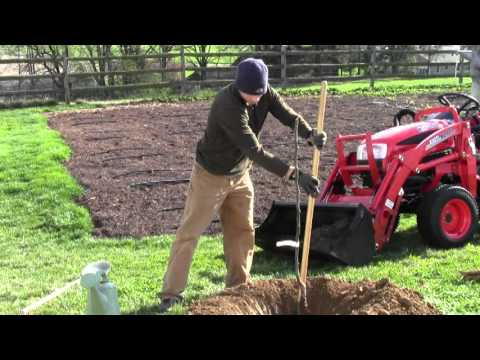*If you would prefer to watch an instructional video on how to plant a bare root fruit tree, there is a video at the bottom of this article.
What is a bare root tree?
A bare root tree is just like it sounds. It comes with the tree, roots, and no soil. This is extremely beneficial to online shippers, as it makes the trees extremely light to ship. I received three trees from Adams County Nursery that weighed less than ten pounds all together. I would not buy bare-root trees from a big-box store, as it is hard to know how they have been cared for. It is best to buy direct from the grower if possible. I have had good luck with the trees from Adams County Nursery.
What do you do if you can’t plant them right away?
When you get the trees, they will not have any leaves on them, and they will be dormant. The roots are typically covered in sawdust and plastic. The roots should be moist. If you keep them in a cool, dark place and make sure the roots stay moist, they can stay like this for 2 weeks. If you need to wait longer than this, they will need to be heeled in.
When to plant them?
Early spring is the best time, but the ground must not be frozen.
How to plant bare root fruit trees?
1. Dig a hole approximately 18 inches deep and 18 inches wide. This will vary depending on how small or big the root system is. Do not add any manure or fertilizers to the hole. In most cases, the existing soil is fine for the backfill.
2. Put the tree in the hole so the roots lay naturally. For apples, plums, and pears, you will want the bud union, which is the knot where the tree is grafted to the root stock, to be 2 inches above the surface. Cherries, nectarines, and peaches are just above ground level.
3. Make sure tree is straight, and backfill the soil a little at a time, adding water and tamping the roots lightly to ensure good soil contact to the roots.
4. Saturate with water.
5. Stake if it is a dwarf rootstock.
6. Add compost as a mulch to fertilize slowly throughout the season. Keep compost at least 2 inches away from trunk of tree. This is a great time to plant a living mulch in the compost. I like to use Dutch white clover. It fixes nitrogen and attracts pollinators. You could also add a nutrient accumulator like comfrey or even certain herbs like oregano, which confuses pests with their strong smells. If you don't plant the compost, something will grow, so it's nice if we (as the gardener) get to decide what would be beneficial for the tree.
7. Immediately prune the tree.
Apple, Plum, and Pear Trees:
If it is an unbranched tree, take it down approximately 25%. Make the cut at a 45 degree angle to ensure water runoff. If it is branched, establish a strong central leader. This will be the tallest branch going straight up. The central leader should be 18 inches above the nearest side branch. If there are other branches growing straight up alongside the central leader, then remove these secondary leaders. Remove side branches that are lower than 12”, and shorten side branches to 12 inches long. Remove limbs with narrow crotch angles, and those branches growing inward, crisscrossing, or broken.
Peach, and Nectarine Trees:
Cut back tree about 35%. Cut side branches back to 4 buds. Remove inwards growing branches, broken branches, and crisscrossing branches. Make cuts at a 45-degree angle with clean, sharp pruning equipment.
8. Install ¼” welded wire around tree to protect trunk from rodents. Do not use the white plastic that Adams County sells, as the trunk does not get enough air, and it can cause disease. I lost two trees this way.
9. If you have deer, make sure the tree is fenced. This can be as simple as a post and wire fence around just the tree to protect the young tree as it grows through the deer-browsing level.
After Care
Maintain good weed control around the tree to discourage competition for nutrients and water. If dry, keep tree watered at least once per week with 4 gallons of water.
Conclusion
I have planted typical container potted trees, very deep-rooted container pots, and bare-root trees. I have had the best success with my bare-root trees. I have to admit that I was skeptical the first time I planted these, but the results were much better than my container-potted trees.
| Type of tree | Labor to plant | Cost | Initial look of tree | Long term performance |
|
Container-Potted |
Low |
High |
Good |
Average |
|
Bare-Root Trees |
Medium |
Low |
Poor, after severe prune |
Very Good |
|
Deep Tap Root Container-Potted |
Very High |
Medium to High |
Average, tree usually small |
Very Good |
Video: How to plant bare root fruit trees
~ Phil Williams
Phil Williams is a permaculture consultant and designer and creator of the website foodproduction101.com. His website provides useful, timely information for the experienced or beginning gardener, landscaper, or permaculturalist. Phil's personal goas are to build soil, restore and regenerate degraded landscapes, grow and raise an abundance of healthy food of great variety, design and install resilient permaculture gardens in the most efficient manner possible, and teach others along the way.
This is a companion discussion topic for the original entry at https://peakprosperity.com/how-to-plant-bare-root-fruit-trees/
